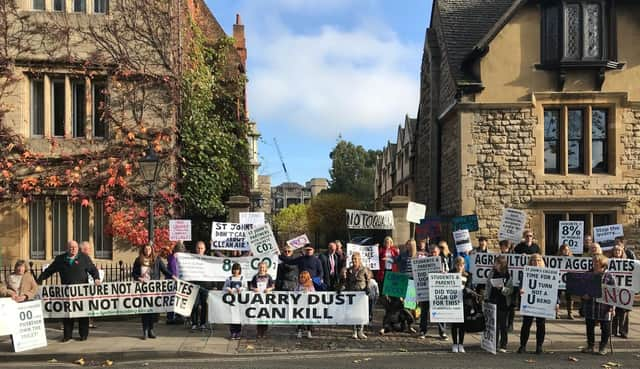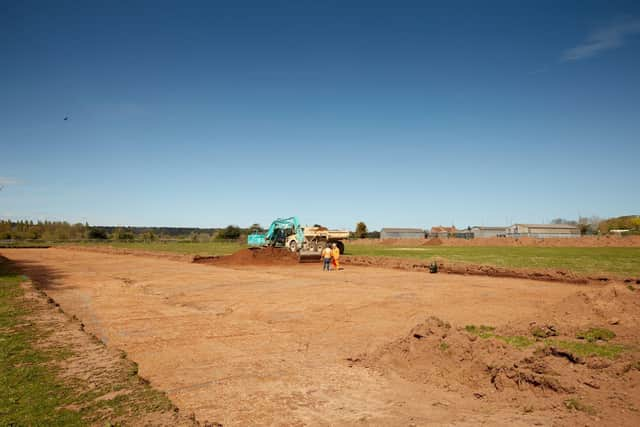Barford residents take their quarry protest to St John’s College in Oxford


Barford residents have taken their seven-year long battle against the creation of a quarry near their village to St John’s College in Oxford.
A group of about 100 villagers along with Warwick and Leamington MP Matt Western protested outside the college last Saturday (November 12) to coincide with the Conference of the Parties (COP27) climate change summit.
Advertisement
Hide AdAdvertisement
Hide AdSt. John’s College, which has assets of over £750 million, owns the land at Wasperton Fields where the proposed quarry will be located.


The college requested that Warwickshire County Council (WCC) include it in their minerals land allocation plan which will allow developer Smiths Concrete to extract large quantities of sand and gravel from the 220-acre site.
It is the publicly stated ethos of the college to adopt policies that support environmental protection and reduce the carbon footprint.
The protestors say ‘the quarry will conflict directly with both of those stated aims’.
Advertisement
Hide AdAdvertisement
Hide AdThey say there is no need for the quarry because it would only serve to contribute to an unneeded excess of between 3 to 5 million tons of sand and gravel being extracted from sites across Warwickshire.


None of the other current or planned quarry sites in the county have such a large community as Barford’s 2,000 strong population so close to them.
Secondly, they say that Barford is so close to the proposed mining process and directly under the path of the prevailing winds that residents have a real risk of inhaling invisible toxic air pollution particulates and that air pollution in the village already exceeds three of the World Health Organisation recommended limits.
And thirdly, they say the large 220-acre site, which is twice the size of Barford, which has rich fertile alluvial soil currently generating at least two salad crops per year, will never be restored to the same level of fertility again with the consequent loss of food production “at a time when the nation needs more than ever to be able to feed itself”.
Advertisement
Hide AdAdvertisement
Hide AdThe protesters handed out leaflets which highlighted their concern that not only will St Johns College risk damaging residents’ lives but also “damaging the college’s glowing global reputation as a world leading centre of excellence in education and research by directly contradicting their own ethos of preaching environmental sustainability”.
Students told the protesters that they had already signed a petition at their student union to stop the quarry.
One of the protesters also handed a leaflet to Ursula von der Leyen, president of the European Commission, who was in Oxford that day.
Malcolm Eykyn, a campaigner against the quarry, said: “Our protest went well, and students were gravely concerned and angry to hear what their college is doing.
Advertisement
Hide AdAdvertisement
Hide Ad"We believe the college doesn’t really understand the implications of what it is about to do.
"By going ahead with this 15-year mining process, toxic silica dust and diesel fume particulates from up to 400 HGV movements per day will become airborne for residents to inhale, exposing them to risk of permanent ill health.
"The carbon footprint of this activity combined with that of the mining extraction machinery will adversely contribute to greenhouse gas emissions into our atmosphere.
"Barford is already registered as an atmospherically highly polluted village.
Advertisement
Hide AdAdvertisement
Hide Ad“We hope that the policy makers at St John’s will share our concern and withdraw their consent for this to go ahead.
"It’s one of the wealthiest colleges in the country and its only incentive is a comparatively small financial gain.
"Does it really want to risk its reputation and our health by proceeding?
A statement from the college says: “The College entered into a contract with Smiths Concrete Limited to take forward a planning application for potential mineral extraction at the land near Barford.
Advertisement
Hide AdAdvertisement
Hide Ad“WCC has stated the site’s potential to provide minerals to meet local needs as part of its Minerals Local Plan 2018-32 which was adopted on July 19 2022.
“Following an extensive consultation process and an independent examination into the soundness of the Warwickshire Minerals Plan by a planning inspector, this site was deemed to be one of the most sustainable sites to meet local needs during the plan period.”
Zoe Hancock, The college’s principal bursar, added: “The college will not allow any activity on its land that does not comply with the local authority’s plan and environmental and safety regulations.
"We will require the land to be returned to good order at the end of the process.
Advertisement
Hide AdAdvertisement
Hide Ad“The provision of minerals, which are required for local housebuilding and infrastructure from the most sustainable local sites, as identified by the Council and scrutinised by a planning inspector, are critical to ensure environmental harm is minimised whilst supporting local economic growth and infrastructure needs.”
Ray Chambers, Smiths general manager: “Much has been said in the local communities close to our proposed sand and gravel quarry at Wasperton Fields, with some wilfully misinterpreting unrelated and historical information which has needlessly raised concerns among residents about our proposals.
“Sand and gravel reserves in Warwickshire are running out and the alternative would be bringing in supplies adding to costs, HGV traffic and transport-related emissions.
"What the protestors in Oxford also ignored is that the potential air quality and dust hazards from quarries are well known and understood and are addressed by stringent regulatory controls set to protect health.
Advertisement
Hide AdAdvertisement
Hide Ad“We’re now sending invitations to all those who would be our near neighbours at Wasperton to visit one of our nearby sites – so they can see first-hand what sand and gravel extraction, alongside progressive restoration is really like.”
For more information about the campaign against the quarry visit http://www.barfordresidents.co.uk/latest-stop-the-quarry-updates/